Learning: The Most Effective Methods To Learn

In our school days, we concentrate on the content without spending much time learning how to learn. Yet, learning how to learn is not just important as a child or student, it follows you in your adult life whenever you receive or even deliver training.
If I’d ask you how you prepare for an exam, last minute bulk revising armed with highlighters would probably come to mind. I know it does for me. Yet, although Re-reading and Highlighting methods are cited as the most popular learning methods, it might surprise you to hear that they’re actually not the best.
Several Psychologists from Kent, Virginia, Duke and Madison Universities have compared the different learning methods commonly used by students and tested their efficacity.
The results were:
- Low Utility Methods: re-reading, highlighting, summarizing, keyword mnemonic, imaginary use (mental and drawn images)
- Average Utility Methods: interleaved practice (mixing the learning of different techniques rather than learning in block one technique then moving to another one), elaborative interrogation and self-explanation (coming up with your own explanation for the facts you are learnings)
- High Utility Methods: practice testing (flashcards, mock tests, summary practice problems, free recall tests, fill-the-blank, multiple choice, …) and distributed practice (spreading out the study rather than cramming it in one go before an exam)
Not just restudy regularly but to actively test yourself, because, in many experiments, it was proven that the retention was far higher when the knowledge was learned then tested rather than learned twice.
It also matters how much and when you retest yourself. The more often you test yourself the better but also the longer the time before tests the better.
Why Is Distributed Practice Testing The Best Method?
It’s all got to do with how the brain forms memories, retrieves them and transforms them into long-term memories.
Once a memory is formed, it is encoded and stored but, if not reinforced, it will just fade away and eventually disappear.
That’s why bulk learning before an exam is not a good long-term solution. Your knowledge will quickly disappear as the short-term memories fade away.
In order to remember what you’ve just learned and remember it for a longer time, you have to strengthen these memories to make them lasting.
The way to strenghten them is to actively recall them.
By answering a question, you don’t just passively relearn the answer, you actively retrieve the answer, often activating other memories or links in the process. This effort in retrieving and replaying the memory develops and strengthens bonds that link the neurons holding the memory. The stronger the bonds, the more chance the memory has to become long-lasting. Hence the importance of the testing.
This works even more if you recall the memory just before you’re about to forget it:
- the day after learning it
- the week after
- the month after (and repeat every month until exam)
and if you want to retain the knowledge post-exam: - a few months after
- a year after
Following these principles (spreading your learning and actively re-testing yourself at regular intervals), you will learn and remember what you’ve learned.
A Great Way To Test Yourself: The Cornell Note-Taking System
There are many methods to test yourself (mock test, fill the blank, flashcards…) but here’s a great (and clever) method devised by Walter Pauk of Cornell University. I particularly like it because you can prepare your test yourself easily and quickly.
- When taking notes, leave a blank column on the left and some space at the bottom.
- After the lesson that day, read your notes and write down in the column any question relating to the content on the right.
- Summarize the content of the page in the empty space at the bottom.
- Later on, when you retest yourself, hide your notes and reply to the questions in the left column.

Further Thoughts
Unfortunately, it will probably take some time before the education system takes these research findings on board and start teaching children how to learn.
But as a parent, you can teach your children how and when to test themselves.
As a trainee, you can apply distributed practice testing.
As a trainer, you can make a real difference not just by teaching your students self-testing methods but also by incorporating as many of the most effective learning methods in the very way you teach:
- summary tests of preceding lessons at a start of a new one
- elaborative interrogation about the new subject you’re about to teach
- interleaved content of preceding lessons when learning new content
- homework following the principles of distributed practice testing


I like the not book idea for self testing.
But I am so lazy!!!
I have forwarded to the my children to ignore.